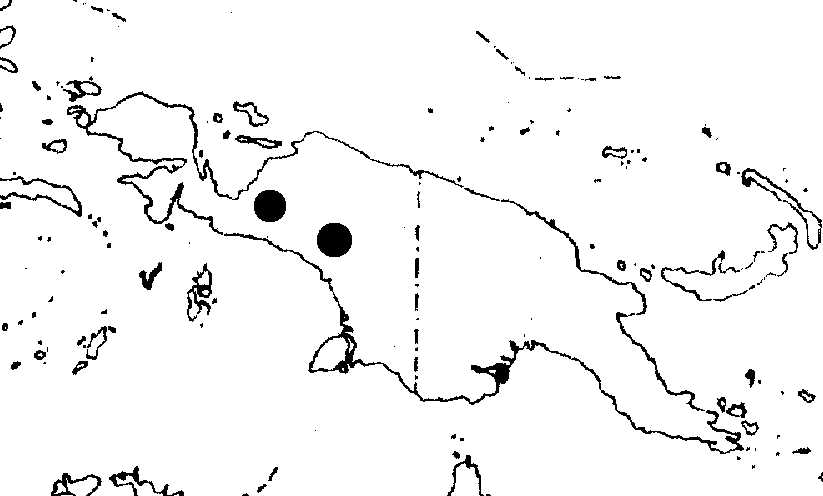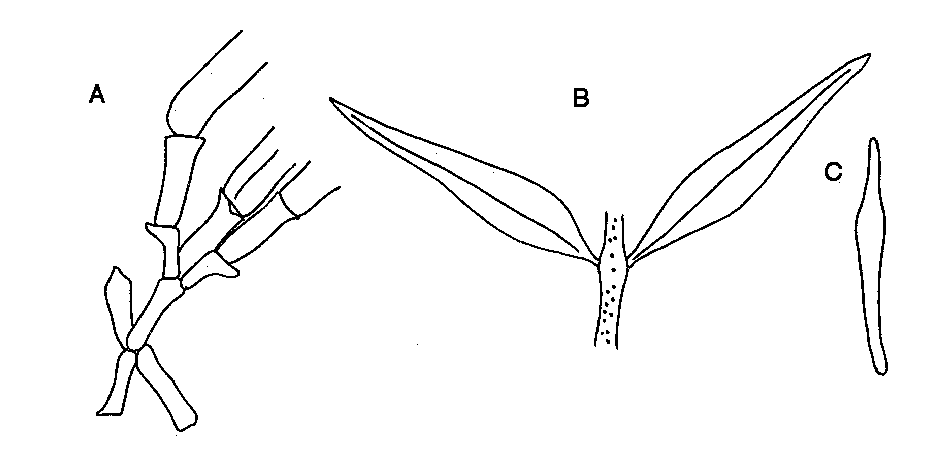
Distribution Map

Description (Barlow 1993)
Amylotheca acuminatifolia Barlow, Austral. J. Bot. 22 (1974) 545. - Type: Eyma 4888 (holo L 952.286-562), New Guinea, Wissel Lakes region, Bivak Prauw between L Tigi and L Enarotali, 1650-1750 m, 19-23.iv. 1939.
For description see Barlow, Austral. J. Bot. 22 (1974) 545. Amylotheca acuminatifolia can be identified by its combination of robust habit, large leaves attenuate at the base to an obscure winged petiole and usually acuminate at the apex to a drip-tip, and robust corolla 45-65 mm long. The flower colour is red in the lower part and yellow above.
The species occurs in a small area in western
New Guinea (Fig. 11; 5 collections seen), recorded at elevations
from 1650 to 2850 m. Other habitat details and hosts are unknown.
Its natural relationship appears to be with the widespread A.
dictyophleba, which has an allopatric distribution, occurring
in New Guinea only in the Papuan lowlands. It differs from
A. dictyophleba in its larger more acuminate leaves and robust
inflorescence and flowers, and may be a local differentiate adapted
to everwet highlands in New Guinea.
Description (Barlow 1974)
Amylotheca acuminatifolia Barlow, sp. nov.
Type.-West Irian; Wissel Lakes region, Bivak Prauw between Lake Tigi and Lake Enarotali, 1650-175Gm alt., Fyma 4888, 19-23.iv.1939 (L 952286562).
Folia opposita; lamina late lanceolate, prope basin latissima, 12-20 cm longa, 2.5-7 cm lata, apice acuta acuminata, margine revoluta, supra lucida, subtus obscura, distincte penninervis, basi in petiolum obscurum et alatum usque ad 05 cm longum attenuata. Inflorescentiae 1-2 in axillis ortae, racemiformes, axe 6-10 mm longo; pedunculi plerumque 4 vel 6, l-3-(6) mm longi, 3-flori; fore mediano sessili lateralibus pedicellatis, pedicelli usque ad 5 mm longi. Flores unibracteatac; bractea acuta, patula, c. 1 mm longa. Calyx anguste cylindricus, 3-4 mm longus; limbus erectus, integer, 1 mm longus. Corolla in alabastro maturo robusta, clavata, apice acuta vel obtusa, 45-65 mm longa; tubus 25-35 mm longus. Antherae 5-7 m longa, parte liberae filamentae aequilongae. Stigma quam stylus triplo latius. Fructus ellipsoideus, c. 12 mm longus.
Bark distinctly and densely lenticellate and minutely furrowed. Petiole obscure, winged, up to 05 cm long; lamina broad lanceolate, 12-20 by 2.5-7 cm, slightly shining above, dull below, attenuate at the base, recurved at the margins, acuminate and acute at the apex; venation distinctly reticulate on both sides. Inflorescences 1 or 2 in the axils; axis bearing usually 2 or 3 pairs of triads, 6-10 mm long; peduncles of the triads 1-3-(6) mm long; pedicels of the lateral flowers of the triads up to 5 mm long; bracts spreading, acute, c. 1 mm long. Calyx narrow cylindrical, 3-4 mm long; limb erect, entire, 1 mm long. Corolla in the mature bud robust, not or slightly inflated at the base, clavate and acute or obtuse at the apex, 45-65 mm long; petals in the open flower united into a tube 25-35 mm long. Anthers 5-7 mm long, about equal to the free parts of the filaments. Style articulate 2-3 mm above the base, persistent on the fruit; stigma globular, 3 times as wide as the style. Fruit ellipsoidal, c. 12 mm long. (Fig. 1, e-g.)
Occurrence. West Irian, Wissel Lakes and Lake Habbema regions (Fig. 3), 1650 to 2850 m altitude.
Specimens Examined. WEST IRIAN: Wissel Lakes region, S. border of L. Paniai, 1750 m alt., Fyma 4539 and 4542, Feb. 1939 and 12.ii.1939 (L); 9 km NE. of L. Habbema, 2850 m alt., Brass 10257, Oct. 1938 (CANE); 18 km NE. of L. Habbema, 2200 m alt., Brass 11352, Nov. 1938 (CANE).
Amylotheca acuminatifolia differs from its congeners in its larger, acuminate
leaves, which apparently function as drip-tips, and in its robust
inflorescences and flowers. This montane species is also singular
in its ecological requirements, as the other species of Amylotheca
all occur in lowland forests.
Illustrations

Amylotheca acuminatifolia. A - portion of inflorescence. B- portion of plant. C - mature, unopened corolla. From Barlow (1974).
Photographs
Amylotheca acuminatifolia
updated 18 January 2007